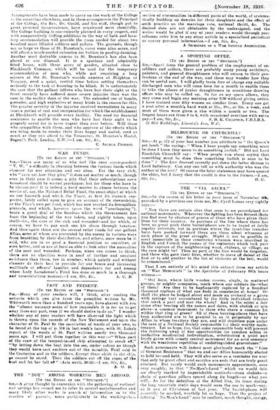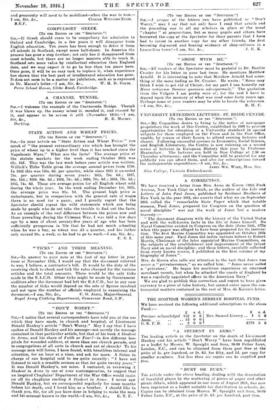THE "VIA SACRA."
(e() THE EDITOR OF THE " $PECTATOR.")
Sri,—In the course of his letter in your issue of November .4th, provoked by a previous one from me, Mr. Cyril Lomas very rightly says :—
"Now there are certain sites that seem to me preordained for national monuments. Wherever the fighting has been fiercest there you End near by clusters of graves of those who have given their lives for their country. In portions of the line where there has been no great push-these burial-places are to be found at fairly regular intervals, but in portions where the front-line trenches have been pushed forward there are these silent witnesses of each phase of the great struggle. Might it not be possible to erect memorials in these cemeteries whereon were inscribed in English and French the names of the regiments which took part in the capture of the neighbouring wood, chateau, or village, as the case might be? Then no part of the line would be forgotten, and those who gore their lives, whether to stave off defeat at the first or to add another to the list of victories at the last, would be remembered."
That L am entirely of his mind this extract from my article on "War Memorials" in the Spectator of February 19th bears witness:—
"Out here, where little wooden crosses, singly, in scattered groups, or mighty companies, mark -wimps our soldiers lie—what of theta? Are they to be haphazardly replaced by a hundred thousand replicas of what one finds in cemeteries at home? Or shall the place be hedged about-and made -an orchard or .a.grove with springy turf encumbered by the little individual tributes that mark a part and mar the whole? And in the midst a fair stone altar hearing all the names and dates, with obelisk or urn above—a common monument to those who share a common lot within that ring of green? All of these burying-places that have -been authorized are to be granted to us in perpetuity by our Allies in whose territory they are, and will doubtlerss pass under the care of a National Society responsible for their worthy maintenance. Let us hope, too, that some responsible body will prevent the frittering away of fine opportunities for common action in ineffective misdirected individualism, substituting a quiet and lovely grove with comely central -monument for an arid cemetery -with its wearisome repetition of undistinguished gravestones."
Such monuments will indeed most gloriously mark the "Line of Greatest Resistance" that we and our Allies honourably elected to hold to—and held. They -will also serve -as a reminder for ever that only by-great effort and sacrifice are ends that are truly great attained. But rarely would such monuments approximate, save very roughly, to that " No-Man's-Land " which we would fain see clearly marked by imperishable sentinels—stone obelisks—a chain of guardian pillars spaced along its length—or what you will.As for the definition of the Allied line, its trace during the long uncertain static days awould seem the one to suark—'say, as it ran at Christmas of last year. The burial-places will assuredly be marked, worthily let us hope. That the project of defining '' Nu-Mares-Land" may be realized, much thought, energy,
and generosity will need to be mobilized-when the war is won.
I am, Sir, &c., Ccouatt Waists's-Emig. B.E.F.













































 Previous page
Previous page